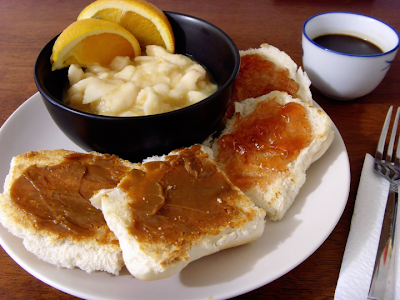Background
Breakfast in Chile is very low key and continental. Every description we read online said it was bread, jam, and coffee. Kitty found that a usual spread is manjar blanco. It is very like dulce de leche, a type of milk caramel very popular in Latin America. I also found a recipe in The South American Table for cherimoya marinated in orange juice and rum, which the author notes is served every day when the fruit is in season.
Cherimoya is native to the Chilean highlands and can grow in colder temperatures. It belongs to the family Annonceae which includes flowering plant shrubs and trees with a mostly tropical distribution. It was domesticated around 1000 BC and has seven varieties under cultivation.
Chirimoya Alegre
- 2 ripe but firm cherimoyas
- Juice of 1 lemon
- ½ cup fresh-squeezed orange juice
- Sugar to taste (optional)
- 2 tbsp rum (optional)

- Slice the cherimoyas in half, and scrape the flesh from the inside of the skin.
- Pick the out the large black seeds and cut the flesh into tiny pieces. (The act of picking out the seeds takes care of a lot of the shredding process.)
- Mix in the lemon juice, then add the orange juice, and sugar and rum to taste.
- Marinate until chilled and serve.
Results and Discussion
There did not seem to be much consensus on the type of jam, so we chose guava since they are also grown in Chile. But the jam was greatly overshadowed by the manjar. Though we had only dulce de leche available; from varying descriptions it is either a good substitute or exactly the same (our jar in fact had "manjar" amongst the various descriptions on the label). Either way the stuff is pure caramel goodness and delicious on toast. Our can of La Lechera brand dulce de leche also had a great recipe on the back for a flan-like desert.
The cherimoya was nice. Before we marinated it had a pulpy texture and it was slightly sweet. It also had a slight lemon flavor and a bit of a coconut aroma. But the marinade's flavor over powered the cherimoya. We had prepared it the night before and left it in the fridge until morning, which seems to be much too long. Some research into other recipes suggest a marinade time of around 2 hours. I will definitely try playing with this fruit in the future or just eat it plain. (Not so much, I don't think, they're about $5 apiece at Market Basket! –Kitty)


